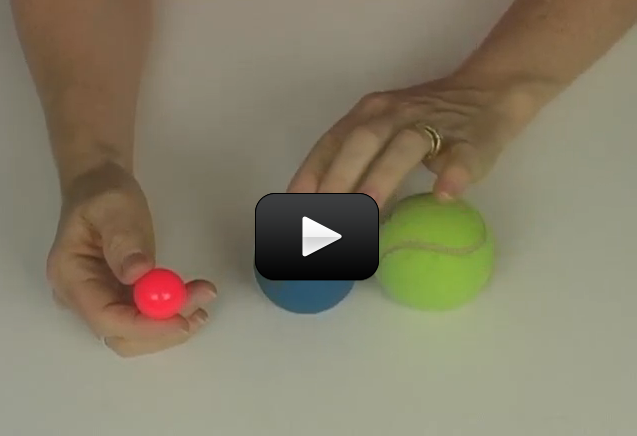This is a satisfyingly simple activity with surprising results. Take a tennis ball and place it on top of a basketball… then release both at the same time.
Instant ball launcher!
You’ll find the top ball rockets off skyward while the lower ball hit the floor flat (without bouncing much, if at all). Now why is that? It’s easier to explain than you think…
Remember momentum? Momentum can be defined as inertia in motion. Something must be moving to have momentum. Momentum is how hard it is to get something to stop or to change directions. A moving train has a whole lot of momentum. A moving ping pong ball does not. You can easily stop a ping pong ball, even at high speeds. It is difficult, however, to stop a train even at low speeds.
Mathematically, momentum is mass times velocity, or Momentum=mv.
One of the basic laws of the universe is the conservation of momentum. When objects smack into each other, the momentum that both objects have after the collision, is equal to the amount of momentum the objects had before the crash. Once the two balls hit the ground, all the larger ball’s momentum transferred to the smaller ball (plus the smaller ball had its own momentum, too!) and thus the smaller ball goes zooming to the sky.
Materials:
- two balls, one significantly larger than the other
[am4show have=’p8;p9;p12;p39;p72;p92;p95;’ guest_error=’Guest error message’ user_error=’User error message’ ]
Download Student Worksheet & Exercises
Do you see how using a massive object as the lower ball works to your advantage here? What if you shrink the smaller ball even more, to say bouncy-ball size? Momentum is mass times by velocity, and since you aren’t going to change the velocity much (unless you try this from the roof, which has its own issues), it’s the mass that you can really play around with to get the biggest change in your results. So for momentum to be conserved, after impact, the top ball had to have a much greater velocity to compensate for the lower ball ‘s velocity going to zero.
You can also try a small bouncy ball (about the size of a quarter) and a larger bouncy ball (tennis-ball size) and rest the small one on top of the large one. Hold upright as high as you can, then release. If the balls stay put (the small one stays on top of the larger) at impact, the energy transfer will create a SUPER high bounce for the small ball. (Note how high the larger ball bounces when dropped.)
What happens if you try THREE?
Exercises
- What is the mathematical formula for momentum?
- Explain momentum in words.
- What happens to the momentum of the bottom ball in this experiment?
[/am4show]


Sure, a basketball and tennis ball will work.
Does it work with a tennes ball as the smaller one and a basket ball as the bigger one ?
It was really amazing on how this worked, my mom was SO surprised when she saw me do the experiment.
THANK YOU!
_____________
Connor, age 11
_____________
It kept my little brother entertained 4ever! 🙂
Google Chrome – I’ll try a different one.
What type of web browser (and version) are you using?
Why can’t I download the worksheet on these experiments?
I used 4 balls!:)
Josiah age 11
I saw it on TV it’s really cool I’m going to see if we have a tennis ball and a basketball (with the right amount of air).
~ Kristian
Great question! What do YOU think?
I would like to know why this only seems to work with balls, and not with other objects. Is it just the shape? What else does this trick work with?
Mary Crawford (age 12)
Awesome! I found that a baseball, when dropped from about four feet up, will only bounce two inches at most. But a baseball on top of a volleyball in this experiment… instant skyrocket!
Mary Crawford (age 12)
I’VE DID this a bunch of times its so fun and i did it with a bunch objects
Keep your head back on this experiment. I was hit in the eye by the tennis ball when it came up. You might want to wear safety glasses when using the small bouncy ball!! ~Sam